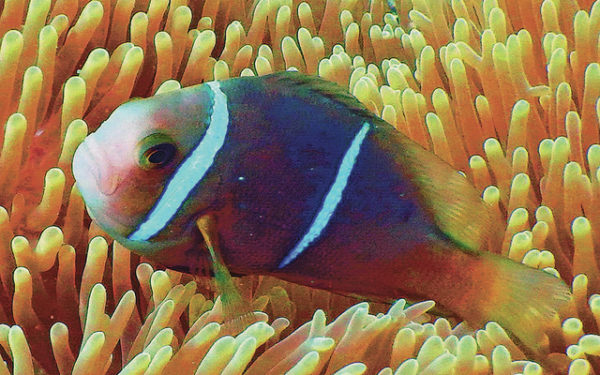Published in the Ocean Watch column, Honolulu Star-Advertiser © Susan Scott
May 2, 2016
North Carolina politicians recently passed a law that requires people in public buildings and schools to use the bathroom corresponding to their gender at birth. When an NPR reporter asked the Rev. Alex McFarland, a North Carolina evangelist, why he supports this legislation, he replied, “This is an issue of natural law … and natural law is the recognition that there are males and females.”
 Most anemonefish are born male and change to female as the need arises.
Most anemonefish are born male and change to female as the need arises.
This is a Clark’s anemonefish swimming off Palau.
©2016 Susan Scott
Excuse me, but what natural law would that be? It’s certainly not one of Mother Nature’s. Researchers have discovered hundreds of hermaphrodite fish species in at least 20 families, and marine invertebrate hermaphrodites are so numerable, they’re uncountable. Because animals with both testes and ovaries employ them in such a variety of ways, researchers sort hermaphrodites into three categories: those that permanently have both ovaries and testes, those that start life as males and turn into females, and those that go the other way, from female to male. And given nature, each group has variations galore.
How do these dual-sexed animals reproduce? One can barely count the ways. One example is a kind of sea bass with both testes and ovaries, and it stays that way. This fish doesn’t fertilize itself, but when it meets another of its kind, they both go off, releasing sperm half the time and eggs the other half.
Some deep-sea hermaphrodite fish do fertilize themselves. This doesn’t do much for the gene pool, but it’s handy for keeping the species going when a fish can’t find a mate.
Anemonefish have another tactic. They inhabit anemones in groups of one large male, one large female and several small, immature males. Only the two big sexually mature fish lay eggs and shed sperm.
The little anemonefish in the clan are biding their time. When the breeding female dies, her mate turns into a female, and the largest juvenile matures to become the new breeding male. If the male dies, same thing. A lucky juvenile moves on up.
Some fish that change sex can swing both ways. In Japanese reef gobies, a female in a group becomes male if the dominant male leaves. If a larger male joins the group later, the changed fish reverts to her former female form.
Parrotfish, wrasses, hagfish, lizardfish, sharks, scorpionfish and other fish families all have members of various genders, being male, female, both, in-between, and changing as the situation requires. A heading in my fish textbook says, “When the going gets tough, the tough change sex.” The Rev. McFarland’s belief that there’s a dividing line between male and female organisms on our planet is wrong. In nature, of which we humans are a part, gender is anything but clear-cut.